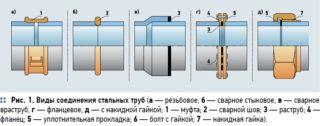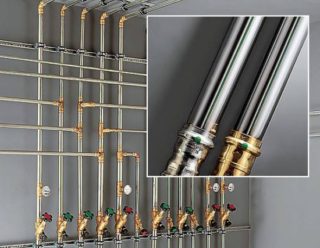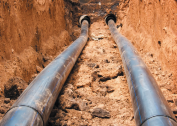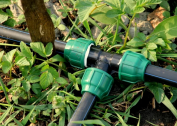Stainless steel pipes are used for laying water supply and heating systems. They have a number of advantages over other materials, which makes communications durable and hygienic. The service life of stainless steel products can reach up to 400 years. At the same time, ordinary carbon steel requires replacement after 10-15 years, so it is gradually being phased out. However, stainless steel pipes have their drawbacks. Before buying equipment, you should consider them.
Application Industries
A large number of stainless steel pipes are on the market. They can perform a variety of tasks: from industrial to domestic.
Fields of application of stainless steel:
- installation of water supply networks;
- arrangement of heating systems;
- gas communications laying;
- creation of fire extinguishing systems.
On an industrial scale, steel is used in the furniture, fuel, medical, automotive, chemical, instrument-making and food industries.
Regulatory requirements
Two types of stainless steel pipes are distinguished: suture (welded) and seamless. Each of them has its own regulatory requirements - the state standard (GOST).
Suture pipes in documents called electrowelded. For their manufacture, the sheet of steel is twisted and the edges are welded together. The seam stretches along the entire pipe. The larger the product, the more sheets are required, and the more seams will result.
In the manufacture of stainless pipes, manufacturers rely on the requirements of standard 11068-81. They determine the size of the wall and the correct diameter. In order for the pipe to meet the specified parameters, molding, calibration, etc. are used.
Seamless pipes produced by the rental method. To give the product the necessary shapes, a special rod is used, on which the workpiece is put on. Production is regulated by the following GOSTs:
- for oil and fuel pipelines - 19277-2016;
- for hot-deformed pipes - 9940-81;
- for cold and heat-deformed - 9941-81.
They are distinguished by the temperature of the workpiece. The standard also defines the minimum and maximum deviations in length, wall thickness, curvature.
Specifications
steel grade
 The main characteristic of stainless steel pipes is the steel grade from which they are made. The chemical composition of the alloys is regulated by GOST 5632-2014.
The main characteristic of stainless steel pipes is the steel grade from which they are made. The chemical composition of the alloys is regulated by GOST 5632-2014.
AISI 316Ti steel is resistant to acidic conditions. This property does not change even at elevated temperatures, therefore, products from this alloy are used in the petrochemical industry. In addition, welded pipes have a long service life.
In the petrochemical and metallurgical industries, pipes are predominantly made of AISI 904L steel. In the manufacture of heat-resistant equipment, steel products are used that are resistant to high temperatures. Among them are brands 310S, S31000, S31008, S31009.
The most corrosion-resistant steel for pipe production is AISI 321. It contains chromium, titanium, and nickel. The material is ideal for laying pipelines, as it does not affect the quality of the water.
Sectional shape
Depending on the shape of the cross-section, the pipes are oval, square, rectangular, etc. In the metal rolling industry they are called profile. Each type of section is used for its intended purpose: some for the installation of building frames, others for the production of furniture, decoration, agriculture and others.
Modern manufacturers also produce stainless steel pipes of more complex sections: round with a hexagonal hole, trapezoidal, triangular, hexagonal, parallelogram, rhombic, hexagonal wrenches.
Diameter
Welded longitudinal welded stainless pipes have an outer diameter of 10 to 1420 mm, and wall thicknesses of 1 to 32 mm.
The standard sizes of spiral-seam steel products are regulated by GOST 8696-74. The outer diameter is from 159 to 2520 mm, the wall thickness is from 3.5 to 25 mm. Segments are made from 10 to 12 meters long.
Hot-deformed seamless pipes in the outer diameter range from 57 to 325 mm, their wall thickness - from 3.5 to 32 mm.
Criterias of choice
When choosing a suitable stainless steel pipe, you need to know:
- profile;
- thickness
- steel grade;
- manufacturing technology.
The choice of metal rolling parameters will depend on mechanical and chemical loads and the duration of their exposure.
Features of installation and connection
 Stainless steel tubular products have several types of connections:
Stainless steel tubular products have several types of connections:
- welded;
- the use of flange-type connectors;
- crimping.
Work should only be carried out by a qualified professional using professional equipment. The process, as a rule, is carried out by a tungsten electrode, and welding itself is performed in an inert gas environment.
There is a more modern way - plasma welding. It allows you to connect pipes to the highest quality. But the equipment for the work is quite expensive, so its purchase is justified only for construction organizations and companies with related activities.
Advantages and disadvantages
Advantages of stainless pipes:
- not destroyed by water hammer;
- bend at any angle, which simplifies installation in cramped conditions;
- durable and resistant to corrosion;
- have an almost unlimited shelf life;
- lungs.
Steel structures have a wide range of pressures and temperatures, so they are suitable for a wide variety of needs. But they also have their drawbacks. For example, high cost. But it is entirely justified, since the replacement of pipes will be needed no sooner than after 200-400 years.
The cost of stainless steel products
The price of stainless steel water pipes is set per linear meter or kilogram. The determining factor is the quality of the material. Many grades include copper, titanium, chromium, nickel and other metals in different proportions. They give the construction additional strength and resistance to corrosion, thereby increasing the cost of the finished product. The price also affects the diameter of the pipes, the type of processing. Polished items are more expensive.
Retail prices:
- 0.68x0.16 mm 12X18H10T seamless, matte - the price is about 1590 rubles / kg;
- 6x1 mm 12X18H10T b / w, matte - about 570 rubles / kg;
- 10x1.5 mm AISI 304 (08X18H10) e / s, matte - about 135 rubles / meter;
- 10х10х1 mm AISI 304 (08Х18Н10) e / s, mirror - about 230 rubles / meter;
- 14x1.5 mm AISI 304 (08X18H10) e / s, polished - about 150 rubles / meter;
- 25x1.5 mm 10X23H18 b / w, matte - the price is about 580 rubles / kg.
Among manufacturers, give preference to better trusted brands. KOFULSO LTD (South Korea), GOFRA-FLEX (South Korea), NEPTUN IWS (Russia) are popular. They have long been on the market and have already managed to win the trust of consumers.



